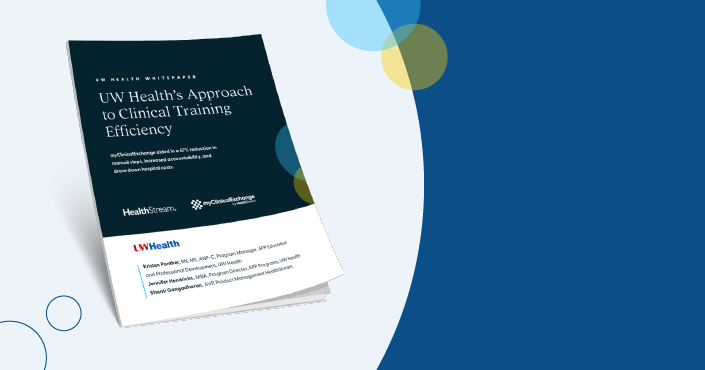







Clinical Placement for the Future of Healthcare – A Conversation with CommonSpirit MT Region and UW Health

Building a competent, compliant, and confident workforce starts with a foundation of support for all of the processes that are necessary to educate students as well as manage and document that process. HealthStream's myClinicalExchange can help users transform this function into an efficient and less chaotic process while saving both time and money. This helps healthcare organizations achieve the ultimate goal of being able to create the kind of student experience that leads to strong clinical outcomes.
A HealthStream webinar entitled "Clinical Placement for the Future of Healthcare: A Customer Discussion With CommonSpirit MT Region and UW Health" shared strategies to enhance clinical evaluation training and advanced clinical supervision training. The webinar was moderated by HealthStream's Caroline Acree, Senior Product Marketing Manager for Clinical Development and featured:
- Shanti Gangadharan, Associate Vice President, Product Management, HealthStream
- Sylvia Robertson, MSN, RN, House-Wide RN Nurse Educator, CommonSpirit MT Region
- Jennifer Hendricks, Program Director, APP Programs, UW Health
- Kristen Panther, Program Manager, APP Professional Development and Education, UW Health
Defining and Standardizing Workflow Processes
The process for clinical skills training, evaluation, and placement in most healthcare organizations can best be described as chaotic and nearly impossible to manage manually, and yet, that is how many organizations are doing it. There are numerous education requests coming from multiple sources requiring several approvals and manual verifications and processes for documentation. Overlapping tasks and manual documentation make the process unwieldy and makes accurate documentation nearly unachievable.
myClinicalExchange transforms the clinical placement process into a systematic and streamlined solution by standardizing the process for all users. The centralized process also makes it easy for leaders to quickly ascertain whether or not all of the tasks that need to be completed by the student before beginning their clinical or online clinical rotation plan have been completed and properly documented. In addition, Gangadharan shared that myClinicalExchange can be customized to include metrics that are important to academic and clinical partners allowing both to get accurate reports.
Managing Priorities for the Student Placement Process
Panther shared that at UW Health, decreasing variation in the placement process was a key priority. With dozens of affiliation agreements, 7 hospitals and more than 80 clinics, there were multiple points-of-entry for learners. To further complicate the issue, there were two different human resources systems. This made it difficult to ensure that everyone had the right paperwork or to even know how many students were in each clinical rotation. myClinicalExchange helped UW to streamline the process, reduce risk and centralize communication.
Robertson shared that at CommonSpirit MT Region they were also able to streamline their processes. With multiple affiliation agreements and programs that range from EMT training to nursing and medical students, they were able to standardize and centralize the way in which students were placed across the entire system.
Minimizing Information Inquiries
The fact that information inquiries might come from a number of different sources has also contributed to the chaos of this process. Robertson shared that requests can come in from unit managers, preceptors, and program chairs. With myClinicalExchange, CommonSpirit MT Region was able to reduce the number of channels for requests making it possible to focus on the rotation and how to better accommodate students. Hendricks shared that changing the process for inquiries meant that UW Health was able to standardize documentation and better direct learners to existing openings and future workforce needs.
Cost and Time Savings
Safer, high-quality care as a result of a more efficient clinical placement process is a huge benefit of myClinicalExchange and the great news is that it does not come at the cost of more time and expense. Gangadharan shared that onboarding time typically averages about 4.25 hours per student. The time savings with myClinicalExchange is substantial. The required time for onboarding drops to just 1.5 hours per student. That is a whopping 65% drop in time which corresponds to roughly $22,000.00 per year. Overall, myClinicalExchange improved clinical rotation plans and clinical evaluation training and achieved a 67% reduction in manual steps, which drove down hospital costs even further.
Hendricks shared that UW Health achieved similar savings and as a result they were able to forego hiring an additional administrative assistant. Instead, they focused those resources on a program support specialist who brings a higher level of support for the learning process, including professional development for preceptors.
Both Hendricks and Robertson shared that the time savings also enabled their organizations to build stronger relationships with their academic and clinical partners.
Preparing students for their future clinical placements can feel chaotic and overwhelming, but it is possible to impose some order on the process while reducing risk and improving your organization's ability to onboard students and easily create accurate reports for your organization and its' clinical and academic partners. myClinicalExchange can help build competence and compliance while helping to reduce the time and costs associated with the process.
To read more about UW Health's approach to clinical training, download the white paper here. You will learn more about efficient ways in which to implement clinical management training and clinical preceptor training and strategies that will lead to reduced costs and improved efficiency.
